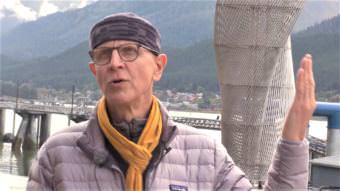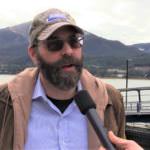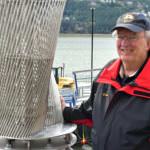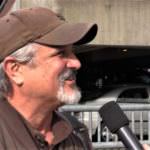Public art … on dolphins? The new, 20-foot-high stainless steel sculptures are nearly identical, and they’re mounted on the mooring dolphins the cruise ships tie up to.

Ten LED-illuminated sculptures have been installed this week. The pieces are a byproduct of the new cruise ship berths.
Local passersby and critics on social media are asking where the money came from and why a non-Alaskan artist was chosen.
“The sculptures are called ‘Aquileans,’ which is a mashup of the Latin word for whale and the Latin word for eagle,” said artist Cliff Garten who designed the structures in his Venice, California, studio.
“There’s a kind of a v-form that represents the fluke of a whale or a bird in flight, which is the sectional plate of the sculpture that rises up the sculpture. And then twists so that you get this really twisting form that rises to a top which is in the shape of a fluke of a whale,” he said.
Garten’s design was fabricated over a year-and-a-half at a foundry in Utah. Three-eighth’s inch thick, solid stainless steel rods were hand bent around a skeleton of tubes and plates to form the creation’s outer skin. Each sculpture weighs 1,500 pounds.
“In making public art really I’m addressing one, the economic constitution of Juneau because the cruise ship industry is why we got the money to do this, I’m addressing the kind of social life of the city by setting up this new public social space. I’m addressing the urban quality of scale between the dock, and the ocean, and the city. And then I’m telling a story with the sculptures. All those things really have to come together in public to make a successful piece,” said Garten.

“I think they’re pretty cool, they’re beautiful,” said Jeff Polizzotto who came down to the waterfront to see the new art.
“That’s a lot of stainless steel. The biggest question I have as a long-time Juneau citizen is how they were paid for,” said Polizzotto.
The berths cost $54 million, and a city ordinance requires at least 1 percent of that go toward public art – these sculptures. According to Juneau Port Director Carl Uchytil, no city sales tax or property taxes were used. Docks and Harbors fees, port dues, cruise ship head taxes and state funds covered it.
Musician Mark Whitman was on the waterfront, too.

“I have to ask myself when I look at this sculpture. What kind of sound is it going to make when the Taku winds blows through it? You know it’s a sculpture, but it might be a musical instrument — I’m really looking forward to that,” said Whitman.
I asked what he thought about it in general, the whole concept.
“Well, I always like more art in the community. I wish it was a little more homegrown, you know? I think he’s from outside the community,” said Whitman.
“The selection panel made a conscious decision from the beginning not to limit it to Alaska artists,” said Gary Gillette, a port engineer for the city who worked closely with the nine-person selection committee. The panel included,“two from the Juneau Arts and Humanities Council, one from the department that is building the project — in this case Docks and Harbors and we had a board member there — one that is selected by the city manager, two that are solicited from the public and selected by the Assembly,” said Gillette.

Due to the large scope of the project, the assembly added three more members.
“So they added a member of the parks and rec advisory committee, and a representative of the Native community and representative of the Filipino community,” said Gillette.
After advertising for artists in Juneau, statewide, and nationally for about two months, eight artists submitted 28 ideas. There was Garten, a Canadian, and six Alaskans — five of whom were from Juneau. Gillette said the sculptures being lit at night impressed the panel.
“The committee felt that was a real benefit for the locals — this wasn’t just for the tourists — they’ll see it in the summer in the bright sunlight or even a day like this or worse, but they’ll be lit all winter long so they’ll be for the locals as well,” said Gillette.
And Mark Whitman? Please let us know if they become musical instruments in the Taku winds.
This weekend, the installation crew is fine tuning the lights.
David Purdy contributed to this report.

